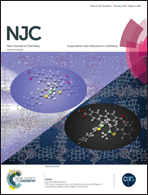An efficient ICT based fluorescent turn-on dyad for selective detection of fluoride and carbon dioxide†
Abstract
A new intramolecular charge transfer (ICT) based fluorescent turn-on ratiometric probe 2 (D–π–A type) has been designed and synthesized by bridging imidazole (donor, D) and benzothiazole (acceptor, A) moieties through a phenyl ring. The photophysical behavior of probe 2 in solvents of different polarities and at different pH values has been investigated. Upon interaction with different types of anions probe 2 showed selective high affinity for fluoride anions (F−) in aqueous DMSO (20%) solution. The ratiometric fluorescence turn-on behavior displayed by 2 with F− is attributed to changes in the ICT process. Job's plot analysis revealed a 1 : 1 binding stoichiometry for 2 + F− interactions with a high binding constant and detection sensitivity (30 ppb). Moreover, a solution of 2 + F− enabled the detection of CO2 (∼100 ppb; 2.29 μM) through enhanced emission. The mode of interaction has been confirmed by 1H NMR titration studies which suggested the deprotonation of the –NH fragment of an imidazolyl unit in the presence of F−.


 Please wait while we load your content...
Please wait while we load your content...